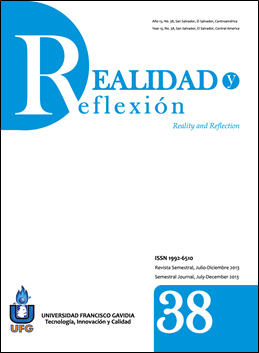Fragility of midsize businesses in El Salvador
DOI:
https://doi.org/10.5377/ryr.v38i0.1831Keywords:
Microenterprises - El Salvador, Economy, Information System – Finance, Financial Analysis, CompetitivenessAbstract
This study is a step towards a diagnosis of Enterprises of the Metropolitan Area of San Salvador, from the perspective of risk faced by economic units, using a methodology to determine why businesses fail or are successful in the market. Process accounting information of these companies and compare them across sectors and sub-sectors to which they belong, according to the International Standard Industrial Classification for all economic activities, facilitate the realization of business benchmarking, is crucial in empirical work. This procedure can be applied to measure the performance of other business and economic production units in other countries. Besides defining business assessment using financial indicators with the respective breakdowns, in the study is possible to specify which sectors are less competitive with the market average. The author defines the solvency and insolvency condition of the companies, to determine the impacts of these indicators on the fragility of the enterprises studied. There is an application of statistical procedures based on the logit model, making possible to know the impacts over the basis of the fragility measurement, and therefore, business risk of midsize businesses in San Salvador Metropolitan Area.
DOI: http://dx.doi.org/10.5377/ryr.v38i0.1831
Realidad y Reflexión Año 13, N° 38: 9-30
Downloads
993
Downloads
Published
How to Cite
Issue
Section
License
© Universidad Francisco Gavidia
Instituto de Ciencia, Tecnología e Innovación (ICTI)
Reality and Reflection
The content and opinions expressed in the publication are the responsibility of the authors of the published articles. The authors assign the publishing and publishing rights, in printed and digital version, to the Universidad Francisco Gavidia.
Proof of originality and assignment of publication rights
The authors must sign a certificate in which they indicate that the text presented for publication is original, unpublished and that it has not been sent for review in another academic publication; In turn, the authors assign the rights of publication and publication to Francisco Gavidia University. The format of this record will be sent through the emails: editores@ufg.edu.sv and jlozano@ufg.edu.sv
The journal Reality and Reflection is housed in the institutional dissemination platforms (web page and in the repository), as well as in databases and other pages of scientific dissemination. The publications of the Francisco Gavidia University are subject to the Salvadoran copyright law, contemplated in the Intellectual Property Law https://www.asamblea.gob.sv/
The content of the work is the sole responsibility of the author, therefore, if for any reason or reason, direct or indirect, the Editor is obliged to pay any compensation to a third party derived from the work of the author, whether it is established in a transaction, agreement or final or enforceable judicial sentence, the Editor may repeat against the Author for the total amount of compensation, plus adjustments, interests and costs that correspond.
It will be the obligation of the UFG to grant five copies of the publication which will be delivered at the UFG Editores headquarters in San Salvador.

